
The Isle of Wight is a county and the largest and second-most populous island of England. It is in the English Channel, between two and five miles off the coast of Hampshire, from which it is separated by the Solent. The island has resorts that have been holiday destinations since Victorian times, and is known for its mild climate, coastal scenery, and verdant landscape of fields, downland and chines. The island is part of the historic county of Hampshire. It is designated a UNESCO Biosphere Reserve.

Sandown is a seaside resort and civil parish on the south-east coast of the Isle of Wight, United Kingdom with the resort of Shanklin to the south and the settlement of Lake in between. Together with Shanklin, Sandown forms a built-up area of 21,374 inhabitants.

Ryde is an English seaside town and civil parish on the north-east coast of the Isle of Wight. The built-up area had a population of 23,999 according to the 2011 Census and an estimate of 24,847 in 2019. Its growth as a seaside resort came after the villages of Upper Ryde and Lower Ryde were merged in the 19th century, as can still be seen in the town's central and seafront architecture. The resort's expansive sands are revealed at low tide. Their width means the regular ferry service to the mainland requires a long listed pier – the fourth longest, in fact, in the United Kingdom and the oldest survivor.

Shanklin is a seaside resort and civil parish on the Isle of Wight, England, located on Sandown Bay. Shanklin is the southernmost of three settlements which occupy the bay, and is close to Lake and Sandown. The sandy beach, its Old Village and a wooded ravine, Shanklin Chine, are its main attractions. The esplanade along the beach is occupied by hotels and restaurants for the most part, and is one of the most tourist-oriented parts of the town. The other is the Old Village, at the top of Shanklin Chine. Together with Lake and Sandown to the north, Shanklin forms a built up area of 21,374 inhabitants (2011).

The Island Line is a temporarily-closed railway line on the Isle of Wight that links Ryde Pier Head with Shanklin on the Island's east coast. The line was electrified in 1967 and a planned 3-month closure for further refurbishment began in January 2021. Trains connect with passenger ferries to Portsmouth Harbour at Ryde Pier Head, and these ferries in turn connect with the rest of the National Rail network via the Portsmouth Direct Line. The line also connects to the Isle of Wight Steam Railway, a steam-operated heritage railway, at Smallbrook Junction. For much of its length the line runs alongside the A3055, criss-crossing this road by means of the Ryde Tunnel and bridges at Rowborough, Morton Common, Lake Hill and Littlestairs.

The Isle of Wight Steam Railway is a heritage railway on the Isle of Wight. The railway passes through 5+1⁄2 miles (9 km) of countryside from Smallbrook Junction to Wootton station, passing through the small village of Havenstreet, where the line has a station, headquarters and a depot. At Smallbrook Junction, the steam railway connects with the Island Line.

Ryde Pier is an early 19th century pier serving the town of Ryde, on the Isle of Wight, off the south coast of England. It is the world's oldest seaside pleasure pier. Ryde Pier Head railway station is at the sea end of the pier, and Ryde Esplanade railway station at the land end, both served by Island Line trains.

The Queen Victoria Building is a heritage-listed late-nineteenth-century building designed by the architect George McRae located at 429–481 George Street in the Sydney central business district, in the Australian state of New South Wales. The Romanesque Revival building was constructed between 1893 and 1898 and is 30 metres (98 ft) wide by 190 metres (620 ft) long. The domes were built by Ritchie Brothers, a steel and metal company that also built trains, trams and farm equipment. The building fills a city block bounded by George, Market, York, and Druitt Streets. Designed as a marketplace, it was used for a variety of other purposes, underwent remodelling, and suffered decay until its restoration and return to its original use in the late twentieth century. The property is owned by the City of Sydney and was added to the New South Wales State Heritage Register on 5 March 2010.
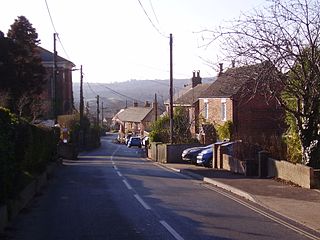
Havenstreet is a village on the Isle of Wight, located about 2 miles southwest of Ryde, in the civil parish of Havenstreet and Ashley.
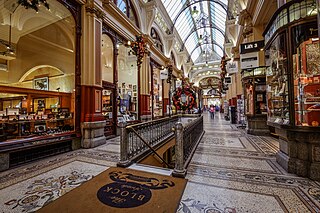
The Block Arcade is an historic shopping arcade in the central business district of Melbourne, Victoria, Australia. Constructed between 1891 and 1893, it is considered one of the late Victorian era's finest shopping arcades and ranks among Melbourne's most popular tourist attractions.
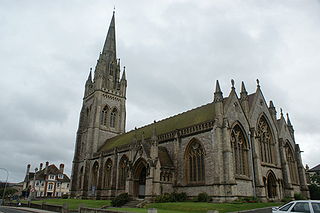
All Saints' Church, Ryde is a parish church in the Church of England located in Ryde, Isle of Wight. The building is a landmark of the Island, the spire being visible from many places around the Isle of Wight - and indeed from the mainland - projecting beyond the skyline. All Saints' is sometimes referred to as the "Cathedral of the Island" It is a Grade II* ecclesiastical listed building.

Holy Trinity Church is a former Church of England parish church located in the town of Ryde on the Isle of Wight. Opened in 1845, consecrated the following year and parished in 1863, it became the rapidly growing town's first parish church. A "fine, gracious" and "imposing" structure with a 134-foot (41 m) spire, it is visible for miles as a landmark at the northern end of the island, along with nearby All Saints' Church. The building has been used as a community centre since it closed for worship in 2014. Historic England has listed it at Grade II for its architectural and historical importance.

There once existed a 55+1⁄2-mile (89.3 km) network of railway lines on the Isle of Wight, which operated both as a self-contained railway network, and as links to ferry services between the island and the South coast of Great Britain. The routes were opened by several companies between 1862 and 1901 and modernised after The Grouping in the 1920s. Most of them were permanently closed between 1952 and 1966, whilst the 8+1⁄2-mile-long (13.7 km) Island Line was temporarily closed in 1966 and rebuilt for electric train services, introduced in 1967. Replacement trains were introduced in 1990, and a major renewal is due in 2021. A further 5+1⁄2 miles (8.9 km) have reopened as a heritage line known as the Isle of Wight Steam Railway and there have been several proposals to expand the network further since the 1960s, either with conventional heavy rail or by conversion to light rail.

Edward Vernon Utterson was a British lawyer, literary antiquary, collector and editor. He was a fellow of the Society of Antiquaries, one of the original members of the Roxburghe Club, a member of the Athenaeum Club, Camden Society and Royal Society of Arts, Recorder of Chichester and a Trustee of the Royal Victoria Yacht Club. He went on to become one of the Six Clerks in Chancery, a position which he kept until his retirement on the abolition of the post in 1842, and also founded the Beldornie Press.

Thomas Hellyer was an English architect of the mid-Victorian era. He was based on the Isle of Wight and was "the leading Island-based architect of the period", but his works can also be found on the mainland—principally in Hampshire—but also further afield. Described by Pevsner as a "very individualistic" and "remarkable" architect, his output included churches, houses, schools and hospitals across the island, during a period of rapid urban development. Many of his buildings have listed status and he "made important contributions to the appearance of the city" of Portsmouth through his extensive work in the area.
Cornelius Jabez Hughes was a British photographer, daguerreotypist, and writer. He was one of the best known portrait photographers in Victorian England, and today his photographs are included in a number of notable museum collections including the National Portrait Gallery in London and The J. Paul Getty Museum in Los Angeles.
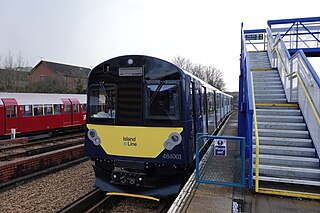
The British Rail Class 484 is a class of electric multiple unit which is being built by rolling stock manufacturer Vivarail for the Island Line on the Isle of Wight. The units are converted from London Underground D78 Stock, originally manufactured in the late 1970s and early 1980s by Metro-Cammell.
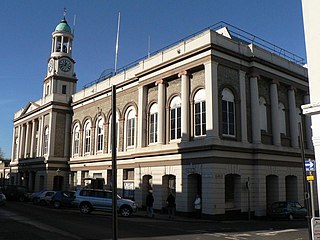
Ryde Town Hall is a municipal structure in Lind Street in Ryde, Isle of Wight, England. The town hall, which was the headquarters of Ryde Borough Council, is a Grade II listed building.
Sport plays a prominent role in the society of the Isle of Wight, an island that is part of England.



















